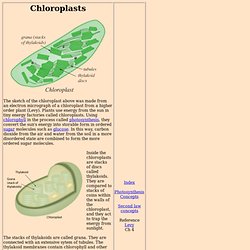

15 House Plants You Can Use As Air Purifiers - Shiretoko. Posted by admin on Thursday, February 18, 2010 · 68 Comments Here are 15 plants that could clean your air for just the price of a few drops of water each day.

First lets check some of the evidence behind the claim that plants can purify your household air: 15 plantes pour respirer un air plus pur - Gizmodo - - Shiretoko. Pearltrees related. Plant "IM"—Scientists Begin to Unravel the Secret Communication of the Green Kingdom. For most of history scientists and mankind in general considered plants to be passive organisms just with no reason or means of communicating with one another.

But new research has revealed that many plants actually ‘chat’ quite a bit over their own networks, which may also indicate that your aunt isn’t quite as crazy as you thought. You know, the one that talks to her petunias and expects an answer. Researcher Josef Stuefer at the Radboud University Nijmegen found that one purpose for plants having their own “chat systems” is to warn each other, leading scientists to conclude that plants are not quite as boring as once supposed.
In fact, many plants form internal communications networks and are able to exchange information efficiently. 20 Visually Arresting but Threatened Forests. (Part of an Exclusive WebEcoist Series on Amazing Trees, Plants, Forests and Flowers) We owe our lives to trees.

Trees provide far more than furniture and fuel. Everyone finds forests to be beautiful, but not many know how hardworking forests really are. The world’s great forests help make our planet hospitable to life; they purify the air, manage nutrients, capture greenhouse gases, create soil, regulate wind and ocean currents, house two-thirds of the world’s plant and animal species, cool the globe, provide subsistence or jobs to 1.6 billion people, and even play a role in weather systems.
15 Eccentric Endangered Trees, Plants, and Flowers. (Part of an Exclusive WebEcoist Series on Amazing Trees, Plants, Forests and Flowers) Did you know that there is a species of tree so rare that only two are known to exist on earth; there are also strange meat-eating flowers and flowers that simply smell like meat.

What they and other unusual plants have in common is both rarity and uniqueness – they are incredible but also endangered. If you enjoyed learning about some of the world’s most beautiful endangered forests and the ultimate list of strange endangered animals, don’t miss the following list of unique endangered plants and trees. Strange Endangered Trees (Image via easyweb) We live in a time some experts are calling the “last great land grab“. Baobob Tree. Fascinating Plant Fakes Sickness to Avoid Predators. We all know that strange animals camouflage themselves for all kinds of reasons, from the need to sneak up on prey to the advantages of being stealthier predators, but this is the first known case of an exotic plant that ‘pretends‘ to be ill as an evolutionary advantage in order to avoid being eaten.

Found in the rain forests of Ecuador these sick-looking plants appear to have already been attacked. As a rule of (green) thumb, plants that compromise their ability to transform sunlight into energy via photosynthesis die out. However, in this case the survivors seem to be those that sacrifice light-harvesting capacity for a clever camouflaged appearance. Typically, the top predator of this particular plant lays its eggs on the leaves , which in turn hatch into larvae that leave a trail of white behind as they feast on the leaves.
Energy in nature, energy in technology - FT Exploring. Most of the ME that we use pours down onto the Earth from the sun.

It is so eager to get here and start heating things up that it zips through the 93 million miles of space vacuum between us and the sun in eight and one half minutes. It heats the oceans and land masses and the air. It makes wind and ocean currents. It evaporates water, forms clouds, and drops rain and snow all over the place. Plants, on the land and in the water, absorb the ME from the sun, then use it along with water (sent to them by the sun) and carbon dioxide to make more of themselves. The Mysterious Everything keeps moving and changing. Chloroplasts. Plants use energy from the sun in tiny energy factories called chloroplasts.

The green color of leaves is attributable largely to these chloroplasts because they contain chlorophyll for photosynthesis. Though obviously oversimplified, the illustration depicts the somewhat elongated sausage type shape with large dimension 5-10 μm and smaller dimension 3-4 μm. Moore suggests 40-200 chloroplasts per photosynthetic cell and about 500,000 per square millimeter of leaf area. There are two membranes, and inside the inner membrane is the gelatanous matrix called the stroma. The stroma contains ribosomes, DNA, and is the location for biochemical synthesis. Energy Cycle from Plants to Animals. Ultradian rhythms in Arabidopsis thaliana leaves in microgravity - Solheim - 2009 - New Phytologist. Introduction The present paper concentrates on short-period, ultradian, movements of Arabidopsis thaliana rosette leaves.

Ultradian leaf movements are common in biology and cover a range of periods from minutes (Desmodium gyrans (or Codariocalyx motorius); e.g. Engelmann & Antkowiak, 1998) to several hours (Phaseolus vulgaris; e.g. Millet et al., 1988). Not only leaf movements but other physiological and chemical systems (often with feedback loops) show oscillations or oscillatory tendencies in the ultradian period range (e.g. Informa Healthcare - Chronobiology International - 9(4):269 - Summary.
Original Article Effects of Tetraethylammoniumchloride (TEA), Vanadate, and Alkali Ions on the Lateral Leaflet Movement Rhythm of Desmodium motorium (Houtt.)

Merr 1992, Vol. 9, No. 4 , Pages 269-277.